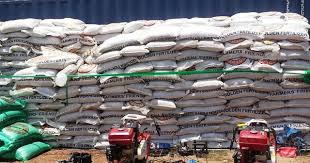Preparing for planting season: Have you done a soil test?
 With the onset of the rainy
season, farmers are either started planting or are busy preparing their land. But
due to the literacy level, the vast majority has failed to conduct a soil test on
their farmlands to determine the nutritional value of the soil.
With the onset of the rainy
season, farmers are either started planting or are busy preparing their land. But
due to the literacy level, the vast majority has failed to conduct a soil test on
their farmlands to determine the nutritional value of the soil.
Knowledge on soil fertility through
soil testing is important because soils can become sick after repeated use. A soil
test helps the farmer to determine whether the nutrients present in the soil
are in the right proportion to grow healthy crops.
Soil test not only helps the
farmer to understand the soils on the farm, it also helps him to deal with the
deficiencies and excesses and ensure that the soil nutritional content is
correct.
Failure to conduct a soil test
before planting usually leads to indiscriminate use of fertilizer by farmers
who wrongly assume that the input is the solution to their desire for bumper
harvests at all times. What they fail to understand is that different plants
require different elements and when certain elements like iron and phosphorous are
above their normal levels in the soil, they affect the growth of some crops
like cabbage, maize, carrots or even potatoes especially on soils that do not
require fertilizers.
Unfortunately, such ignorant practice usually
results in low yields and wasted efforts.
There are several soil tests,
which include testing the soil pH. This checks on the acidity of the soil as
the pH is a key factor in plant growth and it affects nutrients availability in
plants.
 When pH is maintained at the
proper level for a given plant, nutrients are available at the maximum. Most
plants prefer a soil pH of between 6.0-7.0 except for tubers like potatoes,
which need a more acidic environment.
When pH is maintained at the
proper level for a given plant, nutrients are available at the maximum. Most
plants prefer a soil pH of between 6.0-7.0 except for tubers like potatoes,
which need a more acidic environment.
SAMPLE SOIL IMMEDIATELY AFTER
HARVEST
When sampling, a farmer should
divide the area to be sampled into different parts, collecting a minimum of
5-10 samples, then combines them and submits for analysis.
One should avoid sampling very
wet soils or soils that have been recently fertilised, and samples should be at
least 6-8 inches from the ground level. One should avoid areas of high erosion
or those close to trees.
The best time of the year to
sample is immediately after a harvest. Soil sampling can also be done during
the growing season to help in identifying plant growth problems where soils are
sampled when symptoms are present to ascertain the problem and take curative
action during the current growing season.
 The question on how often
sampling should be done depends on individual crops where for perennial plants
like the trees, testing should be done prior to planting and once every two to
three years.
The question on how often
sampling should be done depends on individual crops where for perennial plants
like the trees, testing should be done prior to planting and once every two to
three years.
For annuals such as maize or beans,
soils should be tested once every two years. For large-scale farmers who
regularly use fertiliser, manure or other soil modifications, testing should be
done more frequently to monitor changing soil conditions and prevent the
build-up of excess levels of nutrients or salts.
Get the basics
A soil test should analyse the
following:
1. The nutritional levels of the
soil in terms of nitrogen, phosphorous, potassium, calcium, magnesium, sulphur
and iron.
2. Soil pH, that is below 7.0 is
acidic, at 7.0 is neutral while above 7.0 has high lime.
3. Organic matter, that is, the
nutritional capacity of the soil.
4. The Cation Exchange Capacity.
That is the soil’s ability to hold onto essential nutrients and provide a
buffer against soil acidification.



Comments
Post a Comment